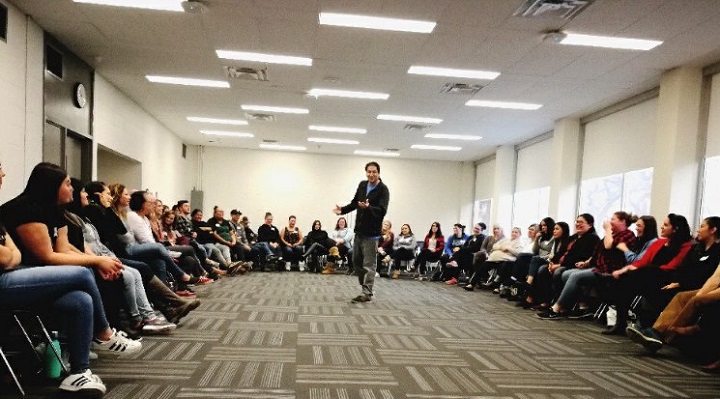Sean Lessard decided he would go beyond the four walls of a classroom to connect with his Indigenous students and the Montreal Lake Cree Nation born man is receiving more recognition for his work with Indigenous youth.

Lessard is now the associate professor of Indigenous Education & Teacher Education at the University of Alberta in Edmonton, and before that he spent seven years as an assistant professor of Indigenous Education Core Studies at the University of Regina.
He researches Indigenous youth leadership and co-founded “Growing Young Movers,” a non-profit organization dedicated to supporting youth and children through programming, workshops, and courses.
Lessard has now received the 2019 early career narrative researcher of the year award from the American Educational Research Association, but the trophy only begins to tell the story of his passioned and thorough approach in education.
After taking note of the disproportionately high drop-out rates of Indigenous high school students compared with non-Indigenous, Lessard wanted to do something about it.
In 2010, 61 per cent of Canadian First Nations young adults hadn’t completed high school, compared to 13 per cent of non-Aboriginal, according to the Assembly of First Nations.
In 2011, 33 per cent of First Nations people aged 25 to 64, 21 per cent of Métis, and 49 per cent of Inuit did not have a certificate, diploma or degree, compared to 12 per cent for the non-Aboriginal population, according to Statistics Canada.

Get daily National news
Lessard believes drop-out rates are remaining high because the status quo isn’t working, but for educators to better understand each indigenous student will lower that rate.
“I think we keep doing the same thing over and over again,” Lessard said. “I knew identity was really important to foster in youth. You need someone to help you find spaces to say ‘it’s OK. I understand your struggles and I also understand your gifts,’ and sometimes in school, our gifts aren’t actualized and we don’t reach out in those ways to fully capitalize on the beautiful things.”
Lessard decided to take a unique approach to get to know his Indigenous students at an Edmonton school in the early 2000s. He sat down for a cup of tea with 250 Indigenous students individually.
- Canadian woman charged with illegally crossing into U.S., kicking border agent’s face
- A new ‘cold’ war? Canada looks to bolster Arctic security, sovereignty
- Canadian furniture industry still ‘reeling’ after Trump pauses tariff spike
- Ottawa propose fines of up to $1M for violating foreign influence registry rules
“Back then our high school success rates were limited, and I knew just by looking at data, a lot of our students weren’t going to university or transitioning to post-secondary. I knew I needed to do something different,” he said.
Lessard said putting each relationship on its own pedestal was important, adding “A kid from Treaty 4 would be different than a kid from Treaty 6. A Dené kid would be different than a Woodland Cree kid. We have different contextual beliefs in our lives.”
One of those 250 students was Michael Swampy, who’s an example of how talking over tea has created real change.
“There was a point when I was taking a 30-2 English course and he looked at me and said, ‘what the hell are you doing? You need 30-1 in order to get into university,’” recalled Swampy. “If that didn’t happen, I don’t know if I would be a teacher, or even have gone to university.”
Swampy is a coach, physical education teacher, and the athletic director at Nipisihkopahk Secondary School on Samson Cree Nation in Maskwacis, which is where he grew up.
“As soon as I got my degree I wanted to come back to my home community of Maskwacis,” he said.
“I could tell that when I came here, students were a lot more comfortable with an Indigenous person as their teacher. I was able to form close relationships with my students. That’s one thing you don’t learn in university, the first thing you have to do is make a relationship with these students. Help them better understand you so they feel safe around you.”
Lessard sees his work coming to fruition through Swampy, and believes he’s one example of how empowering one youth can lead to the empowerment of others.
“I need these young people to see themselves differently so they can carry this work forward,” he said.
A foster child, Lessard didn’t connect with his birth family from Montreal Cree Lake until he was a young boy. His journey to identity inspired his work to help Indigenous youth.
“We need to believe that it’s OK to be Indigenous and to hold ourselves up high, to walk ten feet tall, that’s what I always tell the kids. You should be proud to have a braid, to have your language,” he said.
“If we understand our name connected to place, we will be more sustained as youth, as children, as Indigenous people.”







Comments